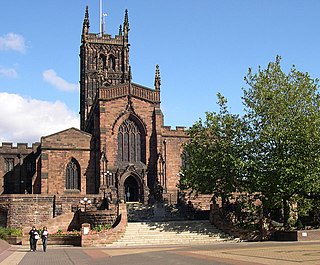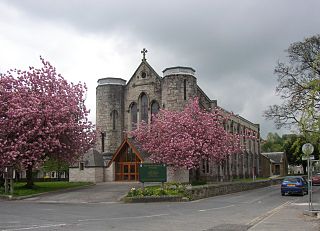A royal peculiar is a Church of England parish or church exempt from the jurisdiction of the diocese and the province in which it lies, and subject to the direct jurisdiction of the monarch.

St Anne's Church serves in the Church of England the Soho section of London. It was consecrated on 21 March 1686 by Bishop Henry Compton as the parish church of the new civil and ecclesiastical parish of St Anne Within the Liberty of Westminster, created from part of the parish of St Martin in the Fields. The church is under the Deanery of Westminster in the Diocese of London.

The Parish Church of St Margaret is a Church of England parish church situated on St Margaret's Road, off Bury Old Road (A665) in Prestwich, Greater Manchester, England. The Grade II listed church, in the Diocese of Manchester, was designed in the Decorated style by the Manchester architects Travis and Mangnall in 1849 as a chapel-of-ease to the ancient Prestwich Parish Church of St Mary the Virgin. Opened in 1851, it was extended in 1863, 1871, 1884, 1888 and 1899, and is notable for its fine Arts and Crafts wood carvings by Arthur Simpson of Kendal and late twentieth-century fittings. The church's daughter church of St George, Simister, is in the same parish.

The Church of St Giles is a parish church in Willenhall, Metropolitan Borough of Walsall, West Midlands, England. Although the current church building dates to 1867, a church has been located in Willenhall since c. 1313, where a chaplain is mentioned in one of the Paget deeds. The current parish priest is Revd Sue Boyce.

Dunston is a small village in England lying on the west side of the A449 trunk road about 3 miles (4.8 km) south of Stafford, close to Junction 13 of the M6 motorway. The population of the village at the 2011 census was 281. It lies at roughly 300 feet above sea level.

St Peter's Collegiate Church is located in central Wolverhampton, England. For many centuries it was a chapel royal and from 1480 a royal peculiar, independent of the Diocese of Lichfield and even the Province of Canterbury. The collegiate church was central to the development of the town of Wolverhampton, much of which belonged to its dean. Until the 18th century, it was the only church in Wolverhampton and the control of the college extended far into the surrounding area, with dependent chapels in several towns and villages of southern Staffordshire.

Grosvenor Chapel is an Anglican church in what is now the City of Westminster, in England, built in the 1730s. It inspired many churches in New England. It is situated on South Audley Street in Mayfair.
The Wodehouse is a Grade II* listed English country house near Wombourne, Staffordshire, notable as the family seat of the Georgian landscape designer and musicologist Sir Samuel Hellier and, a century later, Colonel Thomas Bradney Shaw-Hellier, director of the Royal Military School of Music. For almost 200 years the family owned the Hellier Stradivarius.

St Bartholomew's Church is in Penn, a district of Wolverhampton, West Midlands, England. It is an active Anglican parish church in the deanery of Trysull, the archdeaconry of Walsall, and the diocese of Lichfield. Its benefice is united with that of St Anne, Lower Penn. The church is recorded in the National Heritage List for England as a designated Grade II* listed building.
Charles William Taylor was an English priest who served as Dean of Peterborough from 2007 to 2016.

St Thomas' Church is in School Lane, Parkgate, Cheshire, England. It is an Anglican chapel of ease in the parish of St Mary and St Helen, Neston, the deanery of Wirral South, the archdeaconry of Chester, and the diocese of Chester. The church is recorded in the National Heritage List for England as a designated Grade II listed building. Because of its earlier associations with the fishing community, it has been called the "Fisherman's Church".

The Dean of Wolverhampton was the head of the chapter of canons at St Peter's Collegiate Church, Wolverhampton, until the chapter was disestablished in 1846. The collegiate church was, until that point, a royal peculiar falling outside of the diocesan and provincial structures of the Church of England. Today, the church is district church within a team parish led by a rector, although it has its own vicar and curate within the team. It is now part of the Diocese of Lichfield.

St Paul's Church is in Church Road, Skelmersdale, Lancashire, England. It is an active Anglican parish church in the deanery of Ormskirk, the archdeaconry of Warrington, and the diocese of Liverpool. The church is recorded in the National Heritage List for England as a designated Grade II listed building.

St George's Church is in Castle Street, Kendal, Cumbria, England. It is an active Anglican parish church in the deanery of Kendal, the archdeaconry of Westmorland and Furness, and the diocese of Carlisle. Its benefice is united with those of St Oswald, Burneside, St John, Grayrigg, St Mary, Longsleddale, St Thomas, Selside, and St John the Baptist, Skelsmergh, to form the Beacon Team Mission Community. It was a Commissioners' church, having received a grant towards its construction from the Church Building Commission.
Hon. Henry Lewis Hobart was an English Anglican priest who became Dean of Windsor and thus Dean of Wolverhampton.

The Parish Church of St Luke, Chelsea, is an Anglican church, on Sydney Street, Chelsea, London SW3, just off the King's Road. Ecclesiastically it is in the Deanery of Chelsea, part of the Diocese of London. It was designed by James Savage in 1819 and is of architectural significance as one of the earliest Gothic Revival churches in London, perhaps the earliest to be a complete new construction. St Luke's is one of the first group of Commissioners' churches, having received a grant of £8,333 towards its construction with money voted by Parliament as a result of the Church Building Act of 1818. The church is recorded in the National Heritage List for England as a designated Grade I listed building. The gardens of St Luke's are Grade II listed on the Register of Historic Parks and Gardens.

St Clement's Church is an active Anglican parish church in Chorlton-cum-Hardy, Manchester, England. Its daughter church, St Barnabas, serves the Barlow Moor estate and south Chorlton. St Clement's is in the Hulme deanery in the diocese of Manchester.

St Gabriel's Church is a Church of England parish church in Walsall, West Midlands. Its parish includes Fullbrook, Caldmore, Bescot, The Delves, Palfrey, and Tamebridge and Yew Tree.

The Church of St Peter and St Paul, Heytesbury is the Church of England parish church for the parish of Heytesbury with Tytherington and Knook, Wiltshire, England. It was a collegiate church from the 12th century until 1840. The present building is largely 13th-century and is designated as Grade I listed.

Colonel Thomas Bradney Shaw-Hellier (1836–1910), 4th Royal Irish Dragoon Guards, of The Wodehouse near Wombourne, Staffordshire, and of Villa San Giorgio in Taormina, Sicily, was Director of the Royal Military School of Music. He was a gentleman farmer, described as a leading breeder of Jersey cattle.



















